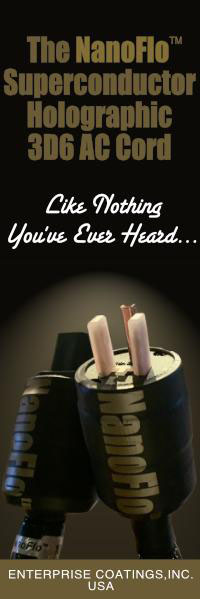Publisher’s Notes: JFK, Jr. Was an Audiophile!
| Commentary |
| Clement Perry |
| July 1999 |
One frosty afternoon out of the blue (more like out of the snow), emerges John F. Kennedy, Jr.! From there the memory plays back like a scene from a favorite movie.
Born and raised in the Big Apple, I’ve seen many things, including celebrities. Of the latter category, no one possessed a more intriguing persona than JFK, Jr., caused more heads to turn, or appeared more down-to-earth. I had the opportunity to help him set up his very first high-end system. Yes, he enjoyed listening to his stereo!
The story begins in an audio salon known as Audio Arts, Ltd. In a downtown Manhattan called SoHo, i.e., South of Houston Street. It’s February, 1995, and I was moonlighting as an audio salesman. One frosty afternoon, out of the blue (more like out of the snow), emerges John F. Kennedy, Jr.! From there, the memory plays back like a scene from a favorite movie. John Jr. ties up his dog to the parking meter right outside the store, comes in, walks directly past me, goes all the way to the back where all the Jamo/Sony XBR/Lexicon/Pioneer home theater setup is crankin’ the latest laser discs (Oliver Stone’s JFK, possibly). He turns back and enters our big reference listening room on his left. I’m smiling now because this is the big money room, and it may be equivalent to a week’s pay in a minute’s work (or a month’s pay if I can get this guy to buy the system in the big room). You KNOW he’s got the bread. Now, only if I get to nail some Goldmund reference digital products or the MBL amps on him ($40k per pair). Chump change for a man of his means. Or so I thought. I just knew that the Eggleston Andras we’d just received would triumph over common sense, and he’d order, at the very least, two pairs for home theater.
John Jr. spoke: “I live around the corner and was interested in doing an upgrade in my loft.” He said he’d passed the store numerous times and was quite attracted (as many were) by the MBL 101 “pods” in the window. The Gallo Nucleus didn’t hurt either. (Can you imagine a non-audiophile getting a load of either one of those speakers for the first time? What an initiation!) True to form, John Jr. finally settled for a much more reasonably priced system consisting of components that we kept in our affordable room closer to the front door — for good reason, too. The Counterpoint stereo amplifier (about $1,800) suited his tastes, along with XLO cables ($600) and Mirage M3’s loudspeakers ($2,500). I don’t know how many times we listened to Rebecca Pigeon, Miles Davis, and Duke Ellington Big Band CDs, along with some classical and rock to judge the merits of his system of choice. John Jr. appreciated the inner detail, sound staging, and the absolute silence this system conveyed. He was amazed by what he was hearing — bitten at once by the audiophile bug.
I was very proud to have offered John Jr. the opportunity to hear what I consider a big part of what makes us joyous. Once again, music served as the common denominator that brought two people from socially different worlds together. (I’d seen John a few times before this, but all I could garner was a routine hello.) For me, a memorable occasion I’ll always cherish in light of his untimely death. John F. Kennedy became an audiophile before my very eyes! I’ll miss him.
Jerry Gladstein’s System Best Sounding I’ve Heard!
I’ve heard the future. I never thought it to be much better than the Meitner Bidat. How wrong I was!
I had the pleasure of visiting Jerry Gladstein, the former publisher of the late, great Fi: The Magazine of Music and Sound, at his home just a few days ago. Jerry has been boasting about his newly acquired digital front end, which consists of the Elgar D-to-A converter and the upsampler that takes 16/44.1 in and converts it to 24/192 out. I was hesitant to hear it because, as good as it’s said to be, I never thought it to be much better than the Meitner Bidat. How wrong I was! As good as the Elgar/upsampler sounded, it was, let’s remember, part of a system composed of the Lamm ML2 single-ended monoblock (which recently received rave reviews from both Jonathan Valin in The Absolute Sound and Sam Tellig in the July issue of Stereophile). Those huge Genesis 200s (with new midrange panels) didn’t hurt their abilities to recreate a tremendous soundstage. The cabling is accomplished via Harmonic Tech’s new Pro Silway MkII.
The sound was so good that it took about half an hour before Uncle Denial would leave me alone long enough to allow me to hear what was going on. (I spend the first 30 minutes talking myself into how closely the new rig and its predecessor sounded.)
The CD that brought me crashing down to reality is the great vocalist Bill Henderson’s “Send in the Clowns.” I couldn’t believe what I was hearing! I have this disc and remembered it sounding a little bright and steely, but very clean with tons of ambiance typical of live date recording (this, however, being a fabulously good one). You know, people moving about with Henderson’s voice swaying to both sides of the mike, but still managing to stay voiced and present. Well, through Jerry’s system, the differences are all too apparent. First off, Bill’s voice had a more human feel — a real person was singing in the room. I know you’ve heard that phrase all too often, and yeah, I am guilty of it, but this is the closest I’ve come. Syllables sounded more true to life through this arrangement of electronics than any other I’ve ever heard. I became more depressed the more I listened. It didn’t stop there — Jerry watched as I slid down his couch in some vain attempt to dodge reality.
Vinyl was next on the night’s menu, as an appetizer, and of course, to shut me up. (I’d always boasted how very close the Mietner sounded to analog.) He’s looking through his vast collection of LPs. One can only guess how he remembers what he’s got. What did he find in this treasure trove? The Six Eyes Columbia pressing of Miles Davis’ “Kind of Blue.” The title sure was apropos. Jerry whipped that onto his Versa Dynamics 2.3, with a Koetsu Pro 4 Cartridge, and after about two notes, I just wanted to go find a place to dig a hole to hide in. The sound was so far and away better than anything I’ve heard, I began to doubt my sanity for a minute. Hey, maybe he spiked my dinner. Come to think of it, the water was a bit too warm.
The term “resolution” instantly took on a new level of meaning.
The next LP confirmed I was losing it, was Solti Conducting Stravinsky’s “Rite of Spring”. I just sat there thinking to myself, jaw agape, sphincter muscle unlaced, where did I go wrong in life? After two torturous hours of this, we went back to the Elgar/upsampler to make sure I didn’t forget what I had previously heard. Stevie Ray Vaughn’s “Tin Pan Alley” sounded as if I’d died and gone to heaven. I really couldn’t believe the silky smooth texture coming off those plucked strings. The quietness was eerie, unlike any I recall (not) hearing. If ever one could swear to hear “quietness,” this was it. It was like on a hot sunny and humid day when you see the heat coming off the pavement distorting the air above. Well, I could see the very same thing happening around the instruments, except replace the wiggly distortion with oodles and oodles of palpable imagery deadlocked on a vast stage. The term resolution instantly took on a new level of meaning.
After being consoled by Jerry, I asked myself what I learned, if anything. Well for starters, it costs more than anyone I know could possibly afford! But more importantly, it instilled in me certain beliefs.
One: The future is bright for digital audio. Just imagine what fun we’ll have with this level of sound reproduction when it becomes affordable!
Two: Don’t believe all that hogwash regarding mismatched components, power-wise. You be the judge. The Lamm ML2’s boast 18.5 watts per channel. (The Genesis comes with their bass amps.) The sound I heard was coming from a loudspeaker with a sensitivity of about 90dB. This should have posed a serious threat to the performance of these amplifiers. In my opinion, just the opposite occurred. No, the amps probably would never drive the system to thunderous levels. But, with the material to which I listened, this was simply the most marvelous system I’ve ever heard, and then some.
So good, I asked Jerry’s permission to write this article.
![]()
Don’t forget to bookmark us! (CTRL-D)
Stereo Times Masthead
Publisher/Founder
Clement Perry
Editor
Dave Thomas
Senior Editors
Frank Alles, Mike Girardi, Russell Lichter, Terry London, Moreno Mitchell, Paul Szabady, Bill Wells, Mike Wright, and Stephen Yan,
Current Contributors
David Abramson, Tim Barrall, Dave Allison, Ron Cook, Lewis Dardick, John Hoffman, Dan Secula, Don Shaulis, Greg Simmons, Eric Teh, Greg Voth, Richard Willie, Ed Van Winkle, Rob Dockery, Richard Doron, and Daveed Turek
Site Management Clement Perry
Ad Designer: Martin Perry





Be the first to comment on: Publisher’s Notes: JFK, Jr. Was an Audiophile!